The Diamond Cross is one of the three prominent cross asterisms in the far southern sky. Located in the constellation Carina, the asterism is formed by Miaplacidus (Beta Carinae), Theta, Upsilon and Omega Carinae. It lies between the brighter Southern Cross and False Cross.
None of the three cross asterisms look like crosses. They do not have central stars and their shapes are more similar to that of a diamond or kite. The Diamond Cross is the least conspicuous of the three. Its stars form an almost perfect diamond pattern, which gives the asterism its name.
Like the False Cross, the Diamond Cross is sometimes mistaken for the Southern Cross in the constellation Crux, an asterism commonly used to find the south celestial pole. The Southern Cross is easily identified as the diamond-shaped pattern near Rigil Kentaurus and Hadar (Alpha and Beta Centauri). The two first-magnitude stars point at Gacrux, the star at the top of the Southern Cross.
Even though the three asterisms are among the most familiar features of the night sky in the southern hemisphere, their location in the far southern sky makes them largely invisible to northern observers. The Diamond Cross is fully visible from locations south of the latitude 20° N.
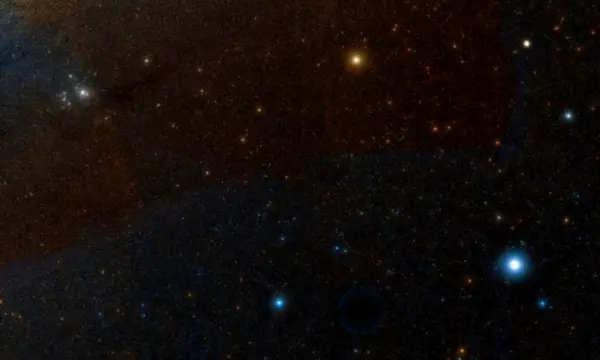
The Diamond Cross, image: Wikisky
Diamond Cross stars
The four stars that form the Diamond Cross are Miaplacidus (Beta Carinae), Theta Carinae, Upsilon Carinae, and Omega Carinae. Shining at magnitude 1.69, Miaplacidus is the brightest star in the asterism and the second brightest star in Carina, after Canopus. Theta, Upsilon and Omega Carinae are the fifth, sixth and seventh brightest stars in the constellation respectively. All four are young A- and B-type stars.
The stars of the Diamond Cross are not physically related as they lie at different distances from Earth. Miaplacidus is the closest of the group at a distance of 113.2 light-years, followed by Omega Carinae at 342 light-years, Theta Carinae at 460 light-years, and the supergiant Upsilon Carinae at about 1,400 light-years.
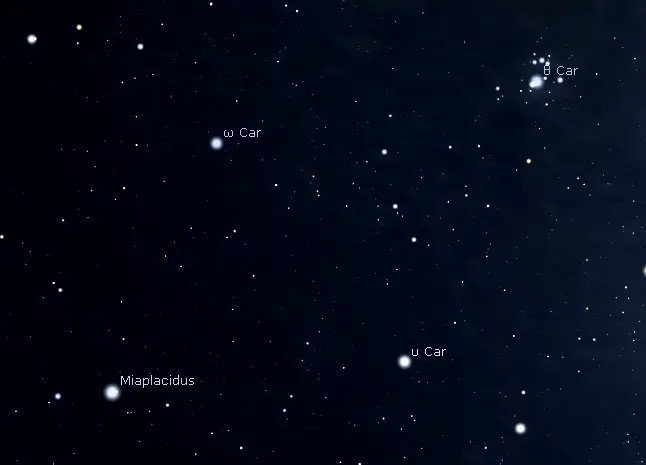
Diamond Cross stars, image: Stellarium
Miaplacidus (Beta Carinae)
Miaplacidus is a white giant star of the spectral type A1III. It has a mass 3.5 times that of the Sun and a radius 6.8 times solar. The star is a fast spinner, with a projected rotational velocity of 145.7 km/s. It is 288 times more luminous than the Sun, with an effective temperature of 8,866 K. Its estimated age is about 260 million years.
With an apparent magnitude of 1.69, Miaplacidus is the 28th brightest star in the sky. It is one of the three navigational stars in Carina, along with Canopus and Avior. It is only slightly fainter than Gacrux, the star at the top of the Southern Cross.
Beta Carinae is the only one of the four stars of the Diamond Cross that has a proper name. The name Miaplacidus is derived from the Arabic miyāh, meaning “waters,” and the Latin placidus, meaning “placid.”
Theta Carinae
Theta Carinae is a spectroscopic binary star with an apparent magnitude of 2.76. It is the brightest star in the Theta Carinae Cluster (IC 2602) and gives the cluster its name.
The primary component in the Theta Carinae system is a hot, blue main sequence star of the spectral type B0.5 Vp. The companion is believed to be an F-type star, but its properties are unknown. The two stars have an orbital period of only 2.2 days. Their estimated age is 4 million years.
Theta Carinae appears younger than other stars in the IC 2602 cluster and is suspected to be a blue straggler, a star created by the interaction or merging of two stars. As a result of close interaction with the companion, the star has a higher mass and appears bluer than other stars in the same area. The less luminous companion is probably the source of mass transfer and may have originally been the more massive of the two stars.
The primary component, Theta Carinae A, is a supernova candidate. It has a mass 14.9 times that of the Sun and is 5.1 times larger than the Sun. With a surface temperature of 31,000 K, it shines with 25,673 solar luminosities. The star is a fast spinner, with a projected rotational velocity of 108 km/s.
Upsilon Carinae
Upsilon Carinae is the most distant and luminous of the Diamond Cross stars. The double star shines at magnitude 2.97 from a distance of 1,400 light years. Even though it is only 12 million years old, the primary component in the system has already left the main sequence and expanded into a supergiant.
The star has a mass 13 times that of the Sun and a surface temperature of 7,600 K. It is classified as a supergiant of the spectral type A8 Ib. It has an apparent magnitude of 3.08.
The companion is a hot blue giant of the spectral type B7 III. It has a mass of 8 solar masses and a surface temperature of 23,000 K.
The two stars are separated by 5.030 arcseconds. If they are physically related, they have an orbital period of at least 19,500 years and a physical separation of about 2,000 astronomical units.
Omega Carinae
Omega Carinae is a hot blue giant star of the spectral type B8 IIIe. It has an apparent magnitude of 3.29 and lies approximately 342 light-years away. The star has a radius 7.20 times that of the Sun and a projected rotational velocity of 240 km/s. With a surface temperature of 11,630 K, it is 918 times more luminous than the Sun.
Omega Carinae is classified as a Be star, a B-type star with emission lines that indicate circumstellar material expelled from the star as a result of its rapid rotation.
Location
The Diamond Cross lies about halfway between the Southern Pointers (Alpha and Beta Centauri) and Canopus, the brightest star in Carina and second brightest star in the sky. Most of the constellation Carina is found between the Diamond Cross and Canopus.
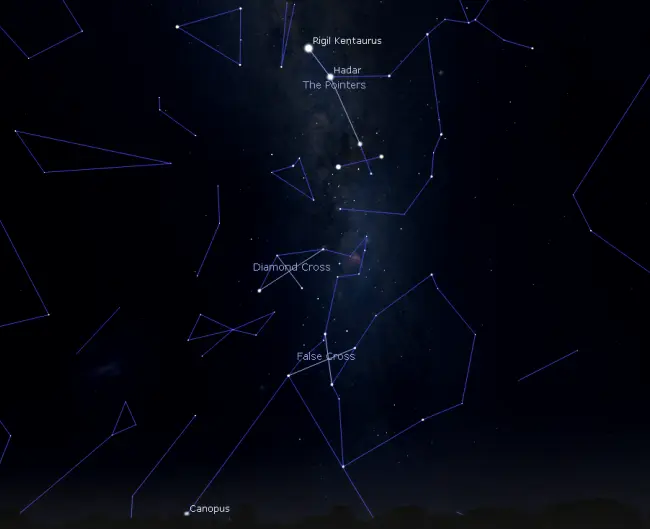
The Diamond Cross, Southern Cross and False Cross, image: Stellarium
Deep sky objects
The brightest deep sky object in the region of the Diamond Cross is the Theta Carinae Cluster (IC 2602), a bright, large open cluster also known as the Southern Pleiades. IC 2602 is the third brightest open cluster in the sky, after the Hyades and Pleiades in the constellation Taurus. The cluster surrounds Theta Carinae, the star at the northeastern corner of the Diamond Cross.
Like the brighter and larger Pleiades, the Theta Carinae Cluster is easily visible to the unaided eye. It has an apparent magnitude of 1.9 and stretches across 50 arcminutes of the apparent sky. The cluster lies 547 light-years away. Its estimated age is 13.7 million years. It is catalogued as Caldwell 102 in the Caldwell catalogue of deep sky objects that can be observed in amateur telescopes.
A line extended from Theta Carinae through Upsilon Carinae leads to NGC 2808, one of the most massive globular clusters in the Milky Way. The cluster has an apparent magnitude of 6.2 and lies 31,300 light-years away. Its estimated age is 10.2 billion years.
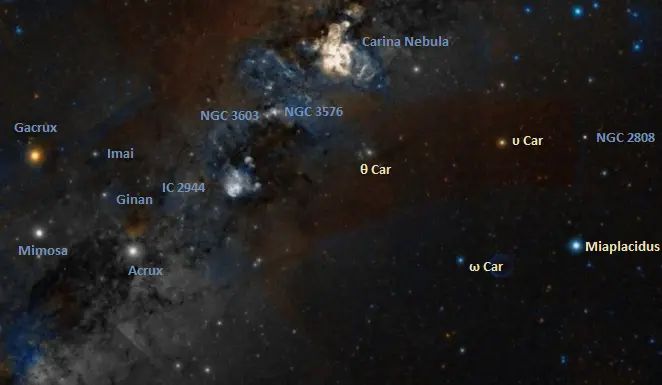
Deep sky objects near the Diamond Cross, image: Wikisky
A line drawn in the opposite direction, toward the Southern Cross, points in the general direction of the Lambda Centauri Nebula (IC 2944), popularly known as the Running Chicken Nebula. IC 2944 is an open cluster associated with an emission nebula in the neighbouring constellation Centaurus. It has an apparent magnitude of 4.5 and lies approximately 6,500 light-years away. The nebula appears near the blue giant Lambda Centauri, but is not associated with it. The star lies much closer to us, at a distance of 470 light-years.
A line extended from Miaplacidus through Theta Carinae leads to two emission nebulae in Carina: NGC 3603 and NGC 3576. The smaller and fainter NGC 3603 shines at magnitude 9.1 and has an apparent size of 12 arcminutes. It is home to the Wolf-Rayet star WR 42e, one of the most massive and luminous stars known. The star has a mass 123 times that of the Sun and shines with 3.2 million solar luminosities.
The brighter and larger NGC 3576 is sometimes known as the Statue of Liberty Nebula because its central region has a shape reminiscent of the monument. The nebula stretches 100 light-years across.
The great Carina Nebula lies in the same region of the sky. It can be found on the imaginary line extended from Miaplacidus through the midpoint of the line connecting Theta and Upsilon Carinae.
The Carina Nebula lies 8,500 light-years away and shines at magnitude 1.0. It is easily visible to the unaided eye on a clear night. It is brighter and four times larger than the Orion Nebula, but less well known because it is mostly invisible to northern observers. The nebula hosts some of the most massive and luminous stars known, including the luminous blue variable Eta Carinae and the Wolf-Rayet star WR 25.
Miaplacidus appears in the same field of view as the spiral galaxy NGC 2836 and the planetary nebula IC 2448 (Henize 2-19). The galaxy has an apparent magnitude of 11.8 and the nebula, 11.1.
Constellations near the Diamond Cross
The Diamond Cross is surrounded by three small southern constellations. The faint Volans (the Flying Fish) is found by following the line of the axis of the asterism, while Chamaeleon lies between the Diamond Cross and Octans, the constellation that hosts the south celestial pole. The brighter Musca (the Fly) appears in the region between the Diamond Cross and the Southern Pointers.
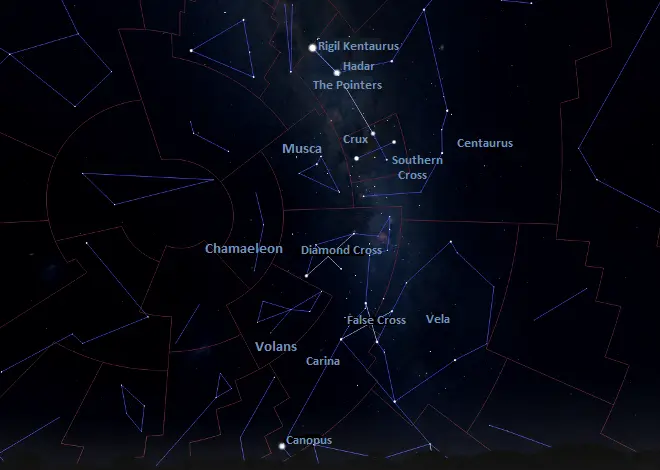
Constellations near the Diamond Cross, image: Stellarium
The best time of year to observe the stars and deep sky objects in Carina is during the month of March, when the constellation is particularly prominent in the evening sky. Carina is circumpolar in the southern hemisphere, i.e. it can be seen throughout the year at some point during the night. However, it is largely invisible to most observers in the northern hemisphere. The entire constellation can be seen from locations south of the latitude 20° N.